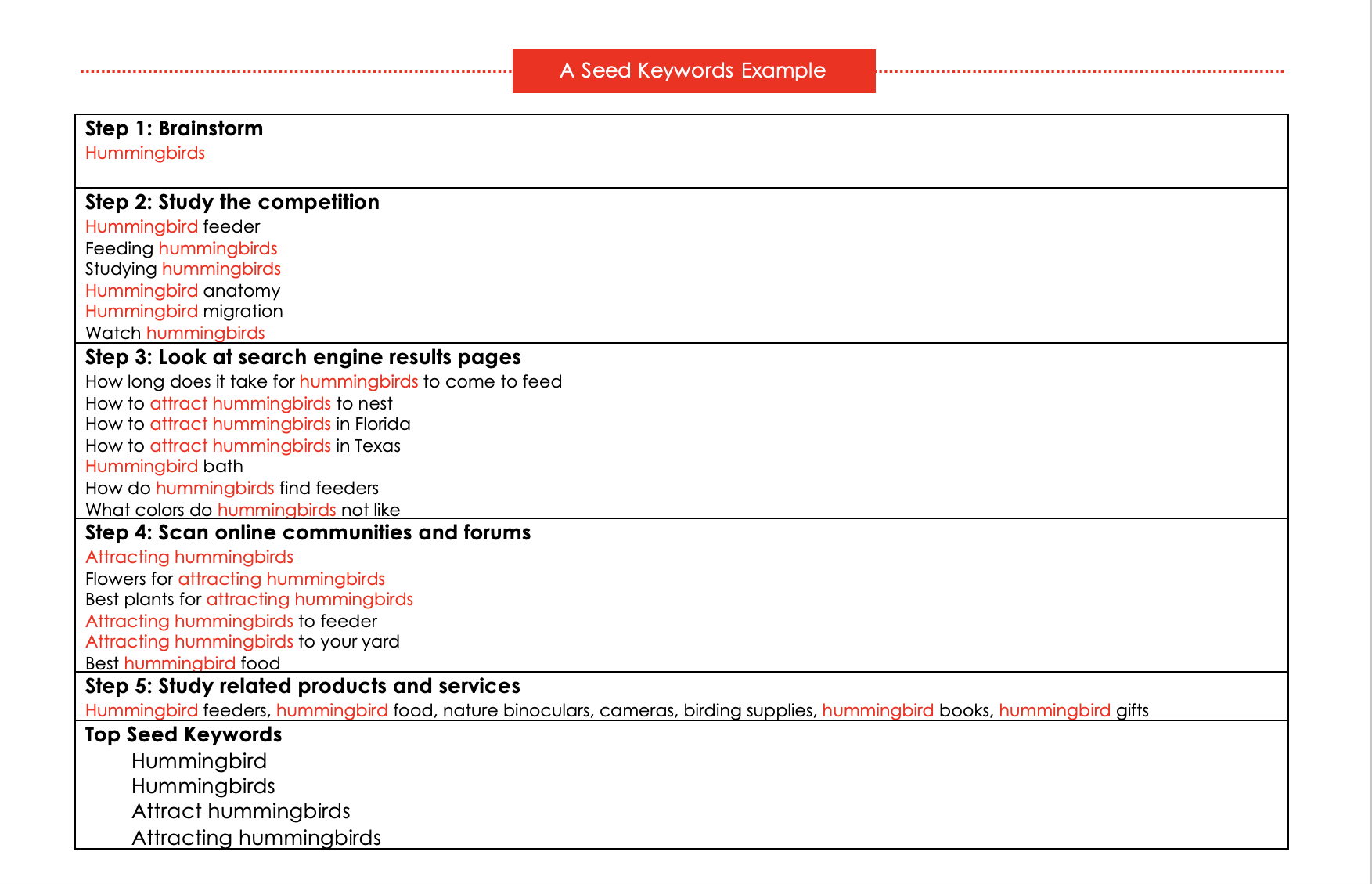Save Time: Get 5 Simple Writing Tips
you can put to use in 10 minutes
How to Find Seed Keywords for Your Blog or Website
Award-winning writer Kathy Widenhouse has helped hundreds of nonprofits and writers produce successful content , with 750K+ views for her writing tutorials. She is the author of 9 books. See more of Kathy’s content here.
Posted 9.9.25
If you’re new to web writing, you want to know about seed keywords. And you definitely want to use them in your online content. On the other hand, if you’ve been writing for years, you may have been using seed keywords along and not known it.
In either case, successful online writing is built on seed keywords – also called root keywords, head keywords, or main keywords.
They’re different from primary keywords, secondary keywords, short tail keywords, longtail keywords. If you get nervous about all those terms, take a deep breath. SEO and optimizing your blog can be intimidating.
You’ll discover that finding the seed keywords for your site is one of the simplest and the most rewarding keyword research tasks. First, some basics.
What are seed keywords?
A seed keyword is a short, broad term that summarizes your site concept.
Here’s what makes them unique.
- Seed keywords are short – generally one or two words.
- Seed keywords are general, rather than specific. They describe a topic from 30,000 feet, without modifiers.
- Seed keywords are high volume, highly competitive search terms. Their generic format means plenty of users type your seed keyword into a search bar. You may not rank for your seed keyword – at least right away – but you’ll use all that search goodness to build a unique list of more specific keywords, with modifiers, for your other pages.
But you need to start with a seed.
Why do you need seed keywords?
You use your seed keywords throughout your blog or website, of course. That’s why you need to choose your seeds early on when you start your site.
But a seed keyword has a greater purpose than simply optimizing your pages. It serves as a building block. Its main job is to help you find other keywords for other pages on your site.
Use this SEO Seed Keyword Finder
to identify the keywords for your blog or website.
How do I find my seed keywords?
Remember what you’re looking for: a list of 1-5 terms that summarize your site concept. Your seed keywords will indicate a slant in your topic, but not one that’s too specific just yet. That will come later when you choose a target audience and begin creating content.
Think of your site concept as the central theme that runs through your entire site. The content on every page of your site will be related to that theme. To identify your seed keyword or keywords, try these steps.
1. Brainstorm
Start with your main site concept. Is it short – just one or two words? If not, pare it down. Record its variations.
2. Study the competition
What other sites or blogs address your topic? Make a list of them. Determine their main seed keyword. What topic pops up over and over, not just on the home page but elsewhere? Is the content current? What slant does it take on your topic? Do these sites address a particular audience or readership? What’s the tone? You may find other online content that shares your possible seed keyword(s), but it may approach the topic from a different angle or target an altogether different set of readers.
3. Look at search engine results pages (SERPs)
Conduct your own search. Enter your potential seed keyword into a search box of your favorite search engine. Study the results, along with the People Also Ask (PAA) list – usually inserted after the first handful of results – and Related Searches list (near the bottom of the search results).
You’re looking for a variety of longtail keywords that include your seed. A nice list indicates a seed keyword that has enough reach to allow you to write a good number of pages or posts.
4. Scan online communities and forums
Look for blog comments, social media posts, and questions on Quora and Reddit threads about your topic. List the handful of terms that pop up over and over.
5. Study related products and services
As you look at what is in the marketplace, make note of products and services that swirl around your topic. Which term or terms appear often?
Let’s find a seed keywords: an example
Let’s look at an example. You like watching hummingbirds from your window. You’ve decided on a site concept: you’d like to create a website for homeowners and hobbyists about hummingbirds. And you’ve discovered that demand for the topic is pretty good.
At this point, you need to do just enough research to identify a seed keyword for your site – one that offer plenty of longtails with which you can build your site. Take the steps outlined above.
1. Brainstorm
Your topic addresses hummingbirds, homeowners, hobbyists, bird watching.
2. Competition
You discover some general birding sites that offer hummingbird information in a conversational tone. You also find scientific information about hummingbirds written for academics. You take notes. Two terms pop up often: hummingbirds and attracting hummingbirds.
3. SERPs
You find plenty of the search engine results include longtail keywords for hummingbirds and attract hummingbirds, including:
- What scares hummingbirds away
- How long does it take for hummingbirds to come to feed
- How to attract hummingbirds to nest
- How to attract hummingbirds in Florida
- How to attract hummingbirds in Texas
- Hummingbird bath
- How do hummingbirds find feeders
- What colors do hummingbirds not like
4. Communities and forums
A quick scan of online communities reveals additional keyword confirmation that you’re on the right track with your seed keywords:
- Attracting hummingbirds
- Flowers for attracting hummingbirds
- Best plants for attracting hummingbirds
- Attracting hummingbirds to feeder
- Attracting hummingbirds to your yard
- Best hummingbird food
5. Related products and services
A bit of time on Amazon reveals a plethora of hummingbird-related products, from feeders to food, binoculars, cameras, supplies, books and gifts.
Your initial instincts were good. Your research confirmed hummingbirds and attracting hummingbirds as strong seed keywords. But you decide to add hummingbird and attract hummingbirds to your seed keyword list.
True, they’re just slight variations on your two main words. But you see that those terms have appeared often enough in your research that you want to use them throughout your site – and more importantly, as a basis for your keyword research going forward. They’re short. They’re general and lack modifiers. Each one returns high-volume, high-supply volume. You’ve found your seed keywords!
Don't make the mistake of targeting too many seed keywords. Doing so only creates confusion when you set out to define your site’s purpose. You need just 1-5, as in our example. And if you’ve done your homework, then probably a couple of those are variations of each other.
Where should I use seed keywords?
- Include your seed as part of your site domain, if possible.
- Plant seed keywords on your website's homepage.
- Use your seed keyword to write a one-sentence summary and tagline for your site.
- Use your seed keyword as often as possible throughout your site. Each page will be optimized with its own longtail keyword, of course. But include your seed keyword where possible. Doing so captures search engines’ attention over time to build your site’s overall rankings. A large volume of quality content centered around a seed keyword builds your site’s topical authority.
How else should I use seed keywords?
Seed keywords are the foundation for your subsequent keyword research. Enter your seed term into a keyword finder tool, you’ll generate a long master list of keyword phrases. Your master list provides a mass of longtail keywords that you can use to write additional pages and posts.
Further, that master keyword list helps you identify topic clusters for your site. These subtopics can be grouped together. Each of those clusters can become a section of your blog or website – including many you may not have thought of before. And you’ll subsequently conduct searches on some of the new keywords your seed returned, thereby allowing you to cover your topic more thoroughly rather than if you’d just guessed what readers want or need about your topic.
By using your seed keywords, you can create navigation for your site. You’ll have to organize the terms, of course. But by gathering a master list from your seed keyword, you can have a ready-made site architecture.
Seed keywords grow other keywords. Those terms grow your site.
But you need to start with seeds.
More about keywords and SEO
What Is SEO Content Writing? Tips for Strong Search Results ...
How Keywords Work: an overview ...
Searching for Keywords? Use These SEO Writing Terms ...
What Are Keywords in SEO, Anyway? A Simple Tutorial ...
6 places to use keywords in web pages and blog posts ...
Build Backlinks and Build Your Traffic: A Beginner’s Guide ...
More Online Writing Tips on our Pinterest board ...
Return from How to Find Seed Keywords to Nonprofit Copywriter home
As an Amazon Associate I earn from qualifying purchases.
Share This Page

Named to 2022 Writer's Digest list
BEST GENRE/NICHE WRITING WEBSITE


Stop Wasting Time!
Grab your exclusive FREE guide, "5 Simple Writing Tips You Can Put to Use in 10 Minutes or Less"














